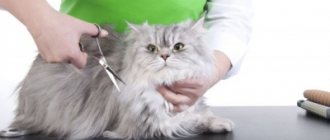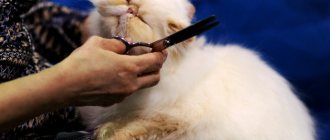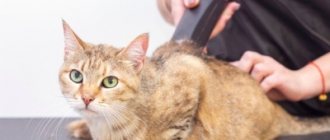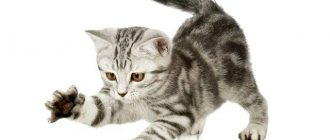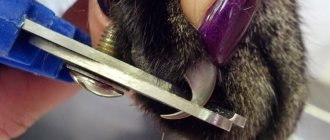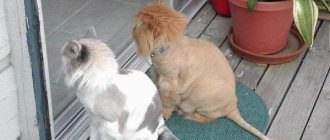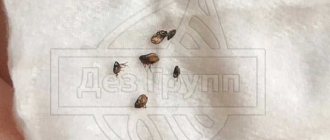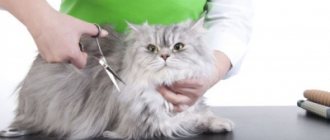Grooming a cat yourself is a responsible undertaking and should be approached with extreme caution. Grooming only makes sense if the cat is long-haired and in the summer, when it is hot. Or if a lot of mats have accumulated. Semi-longhaired, and especially shorthaired, cats do not need to be trimmed. This is unnecessary stress for them. We also do not recommend cutting an animal’s hair for “decorative” purposes, turning it into a lion or dragon simply for the sake of beauty.
Should your cat be groomed?
Before carrying out any manipulations with your pet, you need to figure out whether it really needs human intervention.
The animal's fur is often perceived by owners as an analogue of a good mink coat, which warms in both winter and summer. Some owners, in a fit of love, want to rid the cat of fur, thinking that this will help him survive the summer heat.
In fact, you need to approach this issue carefully. For example, Maine Coons and other semi-longhaired breeds have undercoats and guard hairs of varying lengths, and their beautiful long coats provide a natural layer that protects them from the heat. Therefore, improper haircut leads to overheating or hypothermia.
In what cases is the procedure indicated?
The truth is, cats don't need trimming regardless of the length of their fur. They know how to take care of themselves - they lick themselves, rub against hard objects, and shed regularly. Experienced owners help the cat take care of itself using special tools, do not skip washing time, and brush it regularly. If this is not done, the animal will need the help of a groomer.
In short, a haircut is indicated only in two cases:
- tangles appeared on the pet’s body;
- The pet is sick and needs access to the skin.
The remaining reasons for which the manipulation is carried out are not mandatory, but may be important for the owners.
- Neat appearance of the cat
- Stomach problems after licking a lot of fur.
- The cat does not allow itself to be brushed or bathed.
- The cat's inability to care for itself (old age or illness).
- Trying to control cat hair allergies.
There are studies that show that allergies are caused not by fur, but by protein from cat saliva, so hair removal will not get rid of cat allergies.
Negative consequences and contraindications
After trimming and shaving, minor problems may arise. For example, skin damage during games. Other consequences:
- When an animal is bothered by growing hairs, it begins to itch or does it out of habit.
- The animal licks itself more often, which can lead to slight skin irritation.
- Some cats become depressed, they hide, and begin to take revenge on their owners.
- The structure of the pile changes. Its quality deteriorates, the hairs become thinner, become tangled, and new tangles form faster. This sometimes becomes a reason for disqualification, as the coat no longer meets the breed standard.
- Color may change.
- The elasticity and firmness of the skin decreases.
- When the whiskers are injured, the cat loses orientation, coordination is impaired, and moves uncertainly.
- Cuts provoke the development of inflammation.
- Sometimes hair growth stops in the shaved area. Then, after restoration of the cover, areas of baldness remain.
- Shaving a cat bald disrupts thermoregulation, which causes the development of dermatological diseases, frequent colds, sunburn, and increases the risk of skin injuries.
- An incorrectly done haircut can provoke a cat's desire to bite off its own tail.
Behavior changes less frequently and aggression appears. The cat may suddenly begin to attack, tear up furniture, or walk past the litter box. Usually this is a short-term phenomenon, otherwise the pet needs to be taken to the veterinarian. Some cats are prohibited from being groomed:
- With color-point, tipping color . Otherwise, after cutting, the color of the pile will become darker.
- Shorthair (especially Scottish Fold, British). The exception is varieties of these breeds with long pile.
- Semi-longhaired (Mae Coon, Norwegian Forest, Siberian). Pile saves animals from heat and cold.
Hyperactive cats are not groomed. Otherwise, the procedure is carried out under anesthesia, after sedatives, and it can be difficult to moderate their ardor. Do not shave the inside of the ears or paw pads. It is prohibited to administer anesthesia to animals with chronic diseases. Even healthy people can have heart failure after it.
Types of haircuts
There are three types of haircuts. I propose to look at each type in more detail to understand what procedure your cat needs.
Medical haircut
This procedure is necessary if your pet becomes ill or undergoes medical intervention.
For example, if a cat has shingles, it needs to be trimmed to keep it safe and ensure quality treatment. Read about how to treat lichen in cats in my other article.
When you submit your cat for sterilization, doctors will definitely cut off some of the fur before the operation. Similarly, the cat's fur is trimmed or shaved before the IV is inserted.
This procedure is carried out according to indications and can be done directly in a veterinary clinic.
Hygienic haircut
To maintain the pet's hygiene, a hygienic haircut is performed. Its main purpose is to remove tangles and restore wool.
If you are unable to devote enough time to taking care of your pet’s hygiene, you should regularly visit the groomer and bring the animal for procedures that will further simplify caring for the cat.
Removing tangles is very important. Dirt accumulates underneath them and bacteria and parasites can multiply.
You can cut your cat’s hair for hygiene purposes at home, if you have the necessary tools and have mastered a simple technique, which will be discussed later.
Model haircut
This type is carried out solely at the request of the owner. Some people like it when their pet attracts attention due to the unusual shape of its coat, while others combine hygiene procedures with aesthetics.
Some owners get a model haircut before a photo shoot with a cat or do it several months before the exhibition.
Professional grooming
When it is not possible to trim or shave a cat on your own, or when it is being prepared for exhibitions, competitions, or photo shoots, it is recommended to contact specialized salons or professional groomers. They have experience and special tools, which eliminates damage to the vibrissae and skin trauma.
In salons, a haircut takes from 40 minutes to an hour - it depends on the complexity. To prevent the cat from being nervous about a trip or an unfamiliar place, you can call a specialist home. Anesthesia is rarely used; it disrupts the functioning of the cardiovascular and respiratory systems. The cost of a haircut varies from 700 to 1000 rubles.
Salon prices offer a full range of services - from ear cleaning to final styling. A professional groomer has a larger selection of tools - several types of combs, furminators, shaving machines, and different attachments. The photo shows how difficult it is to do haircuts. Without experience, you can even cripple an animal on your own.
If necessary, the cat is given an injection of a sedative. After the haircut, they will tell you how to properly care for it and when it is necessary to do it again. Only professionals can do a model haircut before a competition; at home, the risk of ruining it greatly increases, and you can injure the animal.
Is it possible to shave a cat's head? This cannot be done unless necessary, since wool saves the animal from the sun, heat, hypothermia, and accidental damage. It is strictly forbidden to shave your head. There are many sensitive vibrissae that cannot be injured. Cats are shaved bald when their fur is stained with substances that are difficult to wash off (cement, mortar, polyurethane foam), before surgery, or when the body is severely damaged by parasites.
How long does a cat's hair grow after shaving? This depends on various factors - the age of the animal, current diseases, nutrition. The fur usually grows back in 6 months. But in case of chronic diseases, deficiency of useful microelements, the cover takes several years to recover.
Grooming cats should be done carefully, carefully, so as not to injure the animal. The pet gets used to its new appearance in a few days. If you have any doubts about your abilities, it is better to contact a professional groomer.
How to prepare for a haircut
Before starting the procedure, choose a place for it - a spacious, flat surface. It is best to use a kitchen table. Remove all unnecessary items from it.
Enlist the help of an assistant. It is difficult to carry out the procedure alone, since it is quite lengthy. Stock up on treats for your pet.
Prepare the necessary tools:
- Trimmer for hard-to-reach and intimate areas.
- Scissors with blunt ends or a tangle cutter.
- Thinning scissors.
- A clipper (if the cat has long hair, you need a powerful electric clipper, at least 45 W).
I also recommend preparing the following materials:
- a thick towel to wipe the cat;
- a disposable diaper in case of an unexpected bowel movement;
- gloves for yourself and your assistant;
- thin comb and brush for combing;
- softening conditioner for combing;
- lubricant for the machine.
Important rules to know
Before starting the procedure, read the rules for its implementation.
- The paws, tail and head are never cut to zero. There are receptors there that allow the pet to navigate in space.
- The longer the machine runs, the hotter it gets. The cat may get burned.
- Do approaches for 10-15 minutes and take breaks, giving your pet time to rest.
- Leave at least 3 mm of fur on the skin, and preferably 1-2 cm.
- Do not press the blade close to the animal's body, as this may injure it.
- Be sure to lubricate the blade so it glides through the fur rather than tearing it.
- 2-3 days before the procedure, bathe your pet (read how to wash a cat in a separate article). However, if there are mats on your body that cannot be removed, postpone bathing.
The right tools
But let's say you have a good reason. Then you need to stock up on the right tools. You can, of course, try to shave a cat with a human clipper, but this usually leads to injuries and a poor-quality haircut. Human and animal hair differ in structure and thickness, so clippers for cats and dogs are different in a number of ways. And it’s also better not to use an ordinary razor, that is, a machine: the cat will resist - then you can injure both it and yourself. In addition, shaving with a machine is inconvenient.
The procedure is performed with a special cat shaving machine. It can be purchased in online stores. It is advisable to choose a machine with a power of at least 45 watts. Cat knives are usually produced in the following sizes:
- 0.5 mm (when you need to open a place for hygiene procedures);
- 1.5-1.6 mm (when you need to remove very matted hair close to the skin);
- 3.2 mm (standard shaving).
It is the length of 3 mm with a slight plus that allows you to ensure that the fur remains soft enough and does not prick, causing itching. But if you use a knife much longer than 3 mm, noticeable transitions with jagged edges will appear, which looks careless.
Step-by-step instruction
It is possible to perform a simple haircut on an animal at home. The main thing is to prepare properly and know the simple rules. Wear thick gloves and have your assistant do the same. Place a towel at hand (in case you need to wipe the cat), tools, peroxide and cotton wool.
- Secure the cat on the work surface. It is best if the pet lies on its side. Your helper should press the cat's back and front paws to the surface.
- If you have not yet gotten rid of tangles, the time to do it is now. Try to separate the lump into fibers, which you then need to comb with a fine-toothed comb. If the tangle is large, cut it out with a tangle cutter or blunt-tipped scissors.
- Before grooming, comb your cat well and use a conditioner spray to remove any tangled hair and make the procedure more comfortable.
- After this, take small scissors or a trimmer and carefully go through the genital area, armpits, nipples and between the fingers.
- When the difficult stage is completed, take up the machine. Use a 3mm or larger comb and cut the fur first on the sides, then on the back and finally on the belly. Follow the growth of the fur. Lubricate the attachment with blade spray as needed.
- You can trim the fur on the paws with scissors.
- If desired, you can use thinning scissors at the end of the procedure.
If you see that your pet is tired or nervous, take a break, calm him down and give him a treat.
I really liked the video about how to groom a cat at home, where the author clearly shows how you can cope with this difficult task in 15 minutes. I hope it will be useful to you too:
Main nuances
Cat owners should be aware that not all animals can have their fur trimmed. The restrictions may be influenced by the following factors:
- Color-point or typing type of color. In this case, the regrown hair on the belly and back will be darker in color than before the haircut.
- Unbearable character and increased activity, when the pet cannot be brought into a calm state. In such a situation, you can use anesthesia, but first you need to take into account all the possible risks. Narcotic drugs can cause cardiac arrest, put you into a coma, and contribute to the failure of the kidneys and liver. If there is no other solution, anesthesia can be replaced with sedatives or muscle relaxants. But such an idea must be approved by a veterinarian, and drugs must be administered strictly under his guidance.
- It is not recommended to cut short-haired cats unless absolutely necessary, since in the heat their vital functions are not disrupted and tangles never form. Grooming of such breeds is only relevant in extreme situations, for example, if the animal is soiled with oil paint.
When planning to cut your cat's hair, you should be aware that the structure of its fur, length and color may change, and the regrowth process usually takes several months. It is forbidden to cut the hair on the animal's head, on the pads of the paws and in the inside of the ears.
What to do if the cat is aggressive
When it is possible to prepare for stressful manipulations, it is better to do so. If you know that your pet will be aggressive, take care of his comfort and your peace of mind in advance.
You can put a protective collar on your cat to protect him from being bitten.
According to the doctor's indications, you can give herbal sedatives in advance to make the process easier.
If the condition of the fur is deplorable, there are tangles, and the cat is wild - only in such cases is anesthesia used. This is done on the basis that anesthesia will cause less harm than the existence of tangles with accumulated dirt and parasites. This procedure is carried out only in the clinic under the supervision of a veterinarian!
What to do after a haircut
After the procedure, calm the animal down and give it a treat. You need to wipe the cat with a towel and comb it. If possible, bathe the animal and dry it properly. Be prepared for the fact that after the procedure the hair may change structure.
The pet's behavior may also change: a vengeful animal may take a shit, a timid animal may hide in dark places. If a cat is hiding in a warm place, it means she is cold. Help get through the fur growth period by dressing your cat in warm clothes and keeping his resting area warm. For the next cut, take note that the previous length brings discomfort to the cat.
Ear inspection
This procedure must be carried out once every 2-3 weeks. But if the need arises, then you should proceed to daily procedures. If the eyes are clean, then you can leave the animal alone.
Sometimes black mucous discharge accumulates in the corners of the eyes - this is typical even for people, there is no need to panic. It is enough to wipe the corners of the eyes with cotton wool or a cloth soaked in ordinary boiled water (do not wet the cloth with boiling water, warm water is best).
But if purulent discharge appears in the corners of the eyes, then it is better to show the animal to a specialist (alternatively, contact the breeder and consult with him).
We suggest you read: Why do cats spit up food?
This procedure should also be carried out once every 2-3 weeks. The ears are inspected for the absence of rashes and any spots. It is recommended to carefully wipe the ears with a piece of cloth soaked in boiled water.
After the procedure, it is necessary to inspect the tissue - if the sulfur is light and has no odor, then everything is fine with the animal. If there is an odor or dark sulfur, you should consult a specialist (this is usually not a sign of any problem, but it is better to be safe).
There is no need to specifically smell the sulfur; if it has a smell, it will be so pungent that it will be simply impossible not to smell it.
